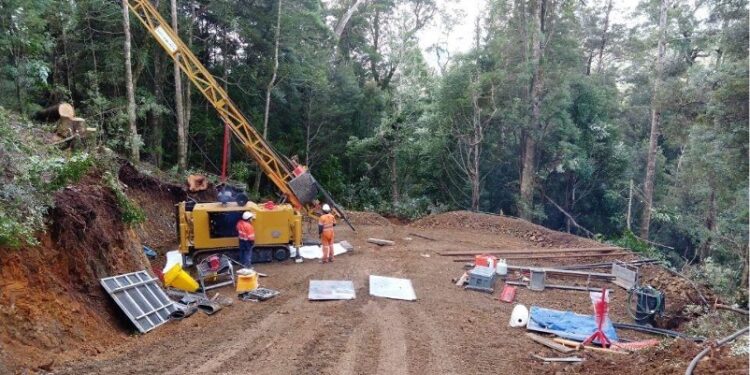Venture Minerals Limited (ASX: VMS) has successfully intersected in ML337, 16 m of potentially tin bearing sulphide rich, magnetite skarn within the extension of the Renison Mine Sequence in Tasmania.
Managing Director, Andrew Radonjic, said the recent exploration drilling at Mount Lindsay was testing a Priority Tin Target delineated along strike from the High Grade Renison Bell (Renison) Tin Mine – one of the world’s largest and highest-grade tin mines.
“Immediate success from the first exploration drilling at Mount Lindsay since 2013, has seen the discovery of a substantial skarn system immediately along strike from one of the world’s most significant and high-grade tin mines (Renison Bell Mine) and adjacent to Venture’s Mount Lindsay Tin Deposit located within Australia’s premier tin district,” Mr Radonjic said.
“The discovery of a potential new tin-bearing skarn system so close to the company’s flagship tin deposit delivers Venture an excellent opportunity to add to the already significant resource base at Mount Lindsay.
“Consumers and investors are becoming extremely focused on ESG-compliant sourcing of tin, Mount Lindsay is well positioned to meet this demand, being in a ESG compliant jurisdiction, with access to renewable hydropower, combined with the Company’s commitment to minimising its carbon footprint, through planned underground mining and processing strategies.”
The Renison Tin Mine has seen mining span over three centuries.
Previous exploration at Mount Lindsay identified potential tin targets located within the carbonate units correlated with the Renison Mine Sequence of the upper Success Creek Group and potentially the extension of the same fault zone (Federal-Basset Fault) that hosts the Renison Mine only 12 kms along strike to the southeast.
The Renison tin deposit is a major carbonate replacement and skarn system with significant pyrrhotite associated with cassiterite mineralisation and hence Venture believed that the airborne EM survey conducted in 2019 would be an ideal exploration tool to lead to a discovery of Renison style tin mineralisation.
The follow-up diamond drilling programme was designed to test EM anomalies identified within the Renison Mine Sequence in the Mount Lindsay area, with ML337 specifically targeting a coincident EM and surface geochemical anomaly (with a nearby significant historic alluvial tin field), favourably located on highly prospective carbonate units that typically dominate the Renison Mine Sequence.
The ML337 intersection comprising 16 m (downhole) of sulphide and magnetite dominated mineralisation within a >150 m thick (downhole) calcsilicate alteration halo typical of the mineralisation style seen in the Company’s adjacent Mount Lindsay Deposit and confirms Venture’s priority target rating.
ML337 shows the Renison Mine Sequence is approximately 250 m thick in the Mount Lindsay area and includes at least five major carbonate (dolomite/marble) units prospective for carbonate replacement and skarn tin, tungsten and magnetite deposits. Venture’s project tenure includes 10 km strike extent of the Renison Mine Sequence.
The Mount Lindsay style of mineralisation is strongly zoned and following the discovery of the new skarn system, Venture has immediately committed to a downhole EM programme to identify more sulphide rich targets while the company awaits assay results from ML337.
The Mount Lindsay Project is already classified by the Australian Government as a Critical Minerals Project3 with an advanced Tin-Tungsten asset which is significantly enhanced by the discovery of a new skarn zone and high priority drill targets within the Renison Mine Sequence in the Mount Lindsay area.
Mount Lindsay is already one of the largest undeveloped tin projects in the world, containing in excess of 80,000 tonnes of tin metal and within the same mineralised body a globally significant tungsten resource containing 3,200,000 MTU (metric tonne unit)4 of WO3.
Tin is now recognised as a fundamental metal to the battery revolution and new technology and the International Tin Association is predicting a surge in demand driven by the lithium-ion battery market of up to 60,000tpa by 2030 (world tin consumption was 328,400t in 2020.)
For further information please visit: https://www.ventureminerals.com.au/












